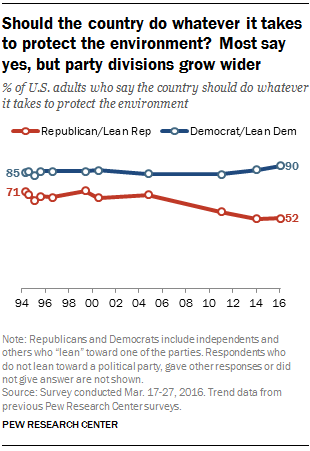
Note: An updated version of this post was published on April 22, 2022.
The 1970s were an important era for American environmentalism. Congress passed the Clean Water Act and the Endangered Species Act, President Richard Nixon established the Environmental Protection Agency, and the nation observed its first Earth Day – created by Wisconsin Sen. Gaylord Nelson – on April 22, 1970.
Nearly a half century later, Earth Day has expanded across the globe, with dozens of countries holding events, ranging from river clean-ups to rallies addressing climate change. Ahead of this year’s events, here are six findings about the public’s views about the environment:

Overall, Americans support protecting the environment, but there are deep partisan divides on the issue. In a Pew Research Center survey conducted last year, about three-quarters of U.S. adults (74%) said “the country should do whatever it takes to protect the environment,” compared with 23% who said “the country has gone too far in its efforts to protect the environment.”
Democrats and Democratic-leaning independents have consistently been more likely than Republicans and Republican leaners to say the country should do whatever it takes to protect the environment. But as Republican support has decreased since 2004, the gap between the two groups has widened to 38 percentage points.

Views about environmental regulations are more partisan today than they were a decade ago. Roughly six-in-ten Republicans and Republican leaners (58%) said in another 2016 Pew Research Center survey that environmental laws and regulations cost too many jobs and hurt the economy, up from 34% in 2007. By comparison, a declining share of Democrats and Democratic leaners hold this view. This partisan gap now stands at 41 percentage points; in 2007, it was 10 points.
Many Americans view protecting the environment as a top priority, but higher shares cite other issues – like terrorism or the economy – as a top priority. More than half (55%) of Americans ranked the environment as a top policy issue that President Donald Trump and Congress should tackle this year, according to a January Pew Research Center survey. But defending the country from future terrorist attacks (76%) and strengthening the economy (73%) were at the top of the public’s priority list.
How environmental protection is prioritized also varies by political affiliation: Democrats and Democratic leaners (72%) are about twice as likely as Republicans and Republican leaners (35%) to cite protecting the environment as a top priority for Congress and the president. There are also differences by age, with adults younger than 30 more likely than those 65 and older to say that protecting the environment should be a top priority (64% vs. 48%).

Three-quarters of Americans are concerned about the environment, but fewer say they make an effort to live out that concern all the time. Among U.S. adults, 75% say they are particularly concerned about helping the environment as they go about their daily lives, according to a 2016 Pew Research Center survey. But only one-in-five Americans say they make an effort to live in ways that help protect the environment “all the time.” Those ages 65 and older are three times as likely as those ages 18 to 29 to say they make this effort all the time (36% vs. 12%).
Millennials (currently 18 to 36 years old) are also somewhat less likely than older generations to view themselves as environmentalists, with 32% saying this, versus at least four-in-ten among older generations, the Center found in a 2014 survey.
Overall, 32% of U.S. adults say they are bothered a lot by people throwing away things that could be recycled. Roughly six-in-ten Americans (61%) who say they always try to live in ways that protect the environment say it bothers them “a lot” when others throw away things that could be recycled. Among those who are less focused on environmental protection, only a quarter say it bothers them a lot when others don’t recycle. People who are environmentally conscious are also twice as likely as others to say that seeing someone incorrectly putting trash in recycling bins bothers them a lot (42% vs. 21%).
Other Pew Research Center data show that a majority of Americans do recycle. Close to half of U.S. adults (46%) said in 2014 that they recycle or reduce waste to protect the environment “whenever possible,” while 30% said they do so “most of the time” and 19% reported doing so “occasionally.” Just 4% of the public said they “never” recycle or reduce waste to protect the environment. Older Americans are modestly more inclined than their younger counterparts to say they recycle and reduce waste “whenever possible.”
What actually gets recycled varies by product type. A Pew Research Center analysis of EPA data found that 99% of lead-acid batteries (the sort found in cars and trucks), 88.5% of corrugated cardboard boxes and 67% of newspapers and directories were recycled in 2013. By comparison, just 13.5% of plastic bags and wraps and 6.2% of small appliances were recycled that year.
Note: This is an update of a post originally published on April 22, 2016.
